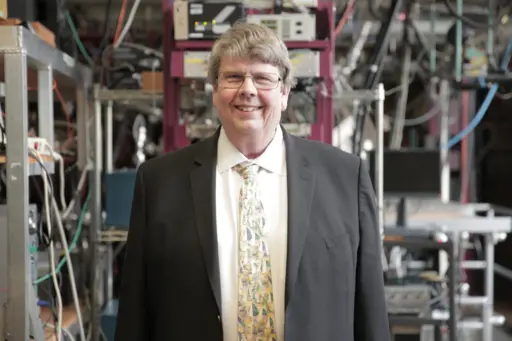On the first floor of Engineering Hall at the University of Wisconsin-Madison, a 20-ton slightly deformed donut-helix-shaped machine forms the containment vessel for an experiment that could bring humanity one step closer toward harnessing the fusion energy that powers our sun.
The donut, which is known as the Helically Symmetric eXperiment, or HSX, currently is the only device of its type in the world. Its unique shape and custom magnetic confinement coils comprise a safe container for plasma—the fourth fundamental state of matter, a hot ionized gas found in stars and lightning bolts.
And now, with a $1.64 million upgrade to its heating system, a new microwave tube, and power supply improvements, the HSX will be able to wrangle plasma of a higher energy level than ever before.
 David Anderson. Photo by Renee Meiller.
David Anderson. Photo by Renee Meiller.
“This is a really exciting pathway toward fusion that builds on the strength we have here,” says David Anderson, a professor of electrical and computer engineering at UW-Madison. “It’s a great opportunity.”
With the upgrades, the HSX will triple the density of plasma that can be contained in its interior and boost its power by a factor of five.
Additionally, its microwave tube, which was donated by Germany’s Max Planck Institute, will allow the HSX to sustain pulses for 10 times longer, thanks to a diamond window with ultrahigh heat conductivity—a step up from the sapphire windows in the current model.
Those longer pulses with higher powers and densities will allow the team of researchers working on the HSX to answer many open questions about plasma confinement, turbulence and power control at the edge of a hot ionized gas.
“This will take us to the next level,” says Anderson. “The HSX is at the top end of a university-scale experiment. It is in the parameter ranges of major national and international fusion experiments.”
Fusion power could potentially meet the Earth’s energy needs for millions of years by harnessing the energy released when two atoms combine to form a heavier element.
The fuel for fusion is deuterium, a “heavy” variety, or isotope, of the common atom hydrogen, which can be readily obtained from seawater. When that deuterium is in the form of a plasma, it can combine with a different hydrogen isotope called tritium, forming helium and releasing copious amounts of energy.
Those reactions readily occur at the tremendously high temperatures and intense gravitational pressures within the cores of stars, but achieving fusion here on Earth requires clever engineering along with perseverance, to capture plasma inside a “bottle” of intensely strong magnetic fields.
One approach, favored by the European facility known as ITER, is a machine called a tokomak. Within its bagel-shaped reactor vessel, the tokamak uses a massive internal current roughly equivalent to 1,000 lightning bolts to achieve a sufficiently high magnetic field to confine the plasma.
HSX favors a less risky strategy.
Instead of internal current, HSX uses external magnets and a undulating, curvy geometry to keep plasma confined. Surrounded by 48 precision-engineered magnetic coils that follow a somewhat twisted helical path along its donut shape, HSX achieves a sort of internal symmetry in the containment fields without a thunderstorm’s worth of current flowing through the machine.
HSX produced a burst of plasma for the first time at 5:15 p.m. on August 31, 1999, and in the intervening 20 years the experiment has yielded a treasure-trove of data, becoming a lodestar for the United States’ fusion research program.
Yet even though the experimental setup was described as the nation’s best hope for fusion energy in a 2015 article in the prestigious research journal Science, HSX has not yet achieved a sustained fusion reaction.
“For fusion you need hot ions,” says Anderson. “We’re getting warmer ions; we’re picking at the edges.”
The upgrades will allow HSX to pick away a little further, yet Anderson and colleagues already have their sights set on building an even bigger and better machine. And what they learn from the improved HSX will be invaluable in designing the next phase of fusion experiments.
“Our hope is that this is really a stepping stone,” says Anderson. “We don’t want the HSX experiment to go on forever. The goal is to corroborate key design precepts for the next step and then move forward.”
David Anderson is the Jim and Anne Sorden Professor in the Department of Electrical and Computer Engineering.